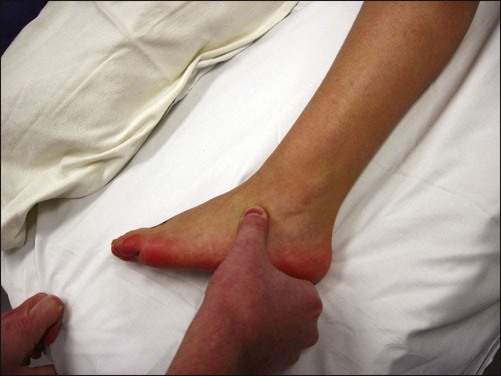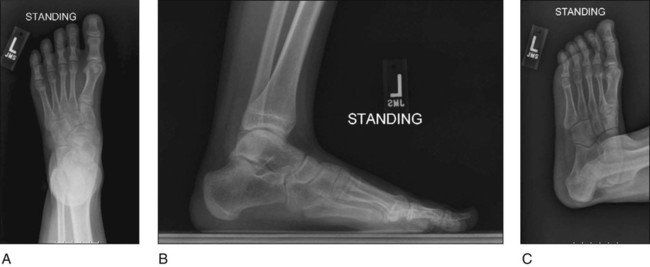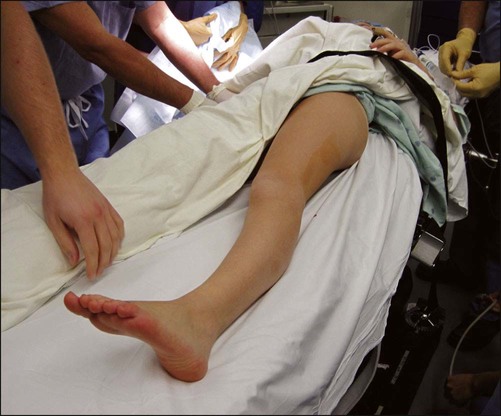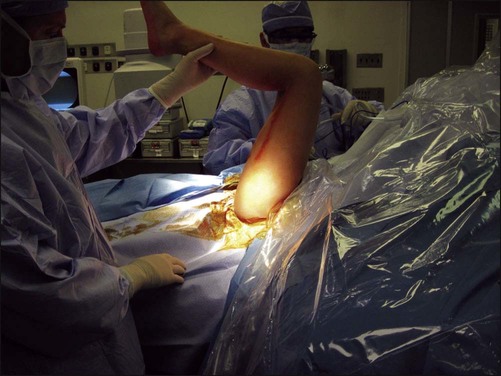• The patient is observed for an antalgic gait, characterized by a decreased stance phase on the affected extremity, and the position of the foot during stance phase is evaluated. • Hindfoot and midfoot alignment are examined. Patients with a calcaneonavicular coalition will typically present with hindfoot valgus and abduction across the midfoot. • The patient is evaluated for flattening of the medial longitudinal arch. • A single-leg heel rise will assess the flexibility of the flatfoot deformity. Failure to reconstitute the arch of the foot is indicative of a rigid hindfoot and suggests the presence of some abnormality within the subtalar or transverse tarsal joints, such as a tarsal coalition. • In a calcaneonavicular coalition, point tenderness may be elicited directly over and distal to the anterior process of the calcaneus (Fig. 1). • The hindfoot is inverted and everted while stabilizing the ankle joint, and compared to the contralateral side. Tarsal coalitions are associated with pain and limitation of subtalar motion. • Anteroposterior (AP), lateral, and oblique views of the foot are obtained. Figure 2A shows an AP view of child with a calcaneonavicular coalition. • The oblique and lateral views of the foot are evaluated. • Standing AP, lateral, and Saltzman hindfoot alignment views may be used to assess alignment.
Resection of Calcaneonavicular Coalition and Fat Autograft Interposition
Examination/Imaging


 The “anteater nose” sign is a prominent anterior process of the calcaneus seen on the lateral view (Fig. 2B).
The “anteater nose” sign is a prominent anterior process of the calcaneus seen on the lateral view (Fig. 2B).
 The oblique view is the best for visualization of a calcaneonavicular coalition. In Figure 2C, note the connection between the anterior process of the calcaneus and the lateral aspect of the navicular
The oblique view is the best for visualization of a calcaneonavicular coalition. In Figure 2C, note the connection between the anterior process of the calcaneus and the lateral aspect of the navicular
 CT scan is necessary evaluate for concomitant talocalcaneal coalitions.
CT scan is necessary evaluate for concomitant talocalcaneal coalitions.
 Magnetic resonance imaging may be helpful in cases in which the diagnosis is equivocal and a cartilaginous or fibrous coalition is present.
Magnetic resonance imaging may be helpful in cases in which the diagnosis is equivocal and a cartilaginous or fibrous coalition is present.
Positioning
 The patient is placed supine on a radiolucent operating room table (Fig. 3).
The patient is placed supine on a radiolucent operating room table (Fig. 3).

 A bump is placed under the hip of the operative leg to internally rotate the extremity.
A bump is placed under the hip of the operative leg to internally rotate the extremity.
 A sterile tourniquet may be used on the upper thigh or an Esmarch tourniquet may be used at the level of the ankle.
A sterile tourniquet may be used on the upper thigh or an Esmarch tourniquet may be used at the level of the ankle.
 The extremity is prepped up to the buttocks to allow for harvesting of the fat autograft. The drapes are placed as proximal as possible to ensure that there is adequate visualization of the gluteal crease (Fig. 4).
The extremity is prepped up to the buttocks to allow for harvesting of the fat autograft. The drapes are placed as proximal as possible to ensure that there is adequate visualization of the gluteal crease (Fig. 4).

Portals/Exposures
 Landmarks are drawn on the skin (Fig. 5). The anterior process of the calcaneus, the cuboid, the fifth metatarsal, and the peroneal and extensor tendons, are marked. An elevator is used with fluoroscopy to find the correct level directly above the coalition.
Landmarks are drawn on the skin (Fig. 5). The anterior process of the calcaneus, the cuboid, the fifth metatarsal, and the peroneal and extensor tendons, are marked. An elevator is used with fluoroscopy to find the correct level directly above the coalition.

 The incision is marked on the skin. It lies between the extensor and peroneal tendons (Fig. 6).
The incision is marked on the skin. It lies between the extensor and peroneal tendons (Fig. 6).![]()
Stay updated, free articles. Join our Telegram channel

Full access? Get Clinical Tree


47: Resection of Calcaneonavicular Coalition and Fat Autograft Interposition












